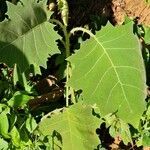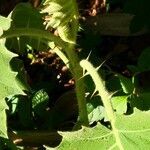Herbs or subshrubs, erect or spreading, 1-1.5 m tall, armed, densely pubescent throughout with pale yellow, many-celled stellate hairs. Stems and branches stout, with flat, erect or slightly recurved prickles 1-8 mm. Petiole 3-8 cm, often with stalked, stellate hairs and erect prickles; leaf blade ovate, 10-20 × 8-18 cm, pubescent as on stems, denser abaxially, prickly along veins on both surfaces, base truncate or subhastate, margin 5-11-sinuate lobed, apex acute. Inflorescences extra-axillary, several flowered, scorpioid-racemose, 1.2-2 cm; peduncle ca. 3 mm. Flowers andromonoecious. Pedicel ca. 1 cm. Calyx lobes ovate, 8-10 mm. Corolla white, subrotate, 1-1.2 × 2 cm. Filaments very short; anthers lanceolate, acuminate, 7-8 mm. Style ca. 9 mm, glabrous. Fruiting pedicel erect, 1-1.5 cm. Fruiting calyx somewhat enlarged, reflexed. Berry orange, globose, ca. 2 cm in diam., densely stellate hirsute, tomentum persistent. Seeds brown, ca. 2 mm in diam. Fl. Jun-Oct, fr. Nov-Dec.
More
A small prickly herb. It grows up to 1 m high. The leaves are rough and thorny. They are also hairy. They are 16-17 cm long by 15-16 cm wide. There are lobes around the edges. The flowers are in groups on the sides. They have 5 white petals. The fruit are round and green. They are 2-4 cm across. They are covered with fine hairs. They have many seeds.


